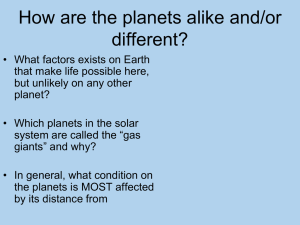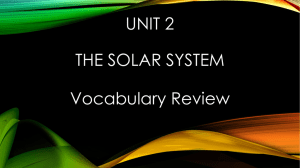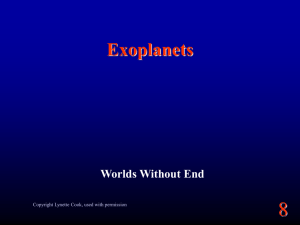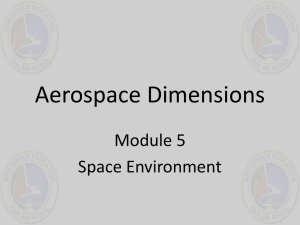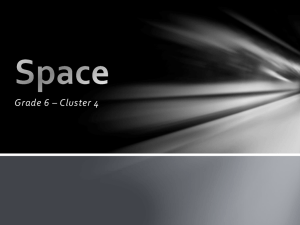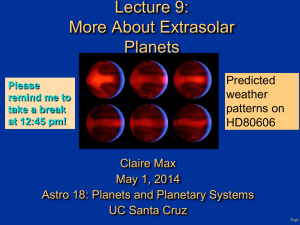Solar System
advertisement
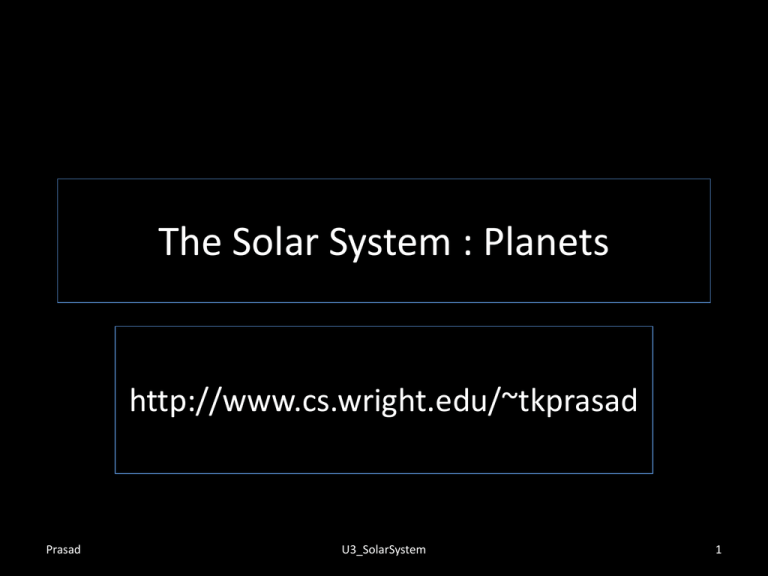
The Solar System : Planets http://www.cs.wright.edu/~tkprasad Prasad U3_SolarSystem 1 SOLAR SYSTEM • The Sun • 8 Planets • 3+ Dwarf Planets • Over 150 moons / satellites of the planets • Comets, meteors, asteroids, and interplanetary dust/space Prasad U3_SolarSystem 2 Simplified Evolution of Solar System • In the beginning, our Solar System was a huge disc of dirt, rocks, gas, ice, etc. • In the middle of this disc, the Sun formed itself and began to glow. • In some distances from the centre, the planets emerged from these rings of dirt, rocks and gas. Scale of Solar System : Distances Scale of Solar System : Sizes SUN : The Star • Composition: 75% hydrogen and 25% helium by mass • Age: The Sun’s age is about 5 billion years. • Differential rotation duration – At the equator the surface rotates once every 25.4 days – while near the poles it rotates once every 36 days • Core conditions – Temperature is 15.6 million Kelvin – Pressure is 250 billion atmospheres Prasad U3_SolarSystem 6 • Sun’s energy comes from nuclear fusion (in which hydrogen is converted to helium within sun’s core). This energy is released as heat and light. • Our sun is classified as a yellow main sequence star. – A star’s temperature determines its “color.” The coldest stars are red. The hottest stars are blue. – Surface temperature (Corona) : 60000 K Prasad U3_SolarSystem 7 Geocentric vs. Heliocentric Theory • Geocentric Theory (or “Ptolemaic” Theory – pronounced “Tole-ah-may-ic”) is an ancient view of the universe based primarily on religion, philosophy, and mathematical ideals. • Heliocentric Theory (or “Copernican” Theory) is a revised view of the universe based on the studies of Nicholas Copernicus, who was a mathematician in the 1500’s. Prasad U3_SolarSystem 8 Prasad U3_SolarSystem 9 PLANETS A planet is a large, round heavenly body that orbits a star and shines with light reflected from the star. Prasad U3_SolarSystem 10 The Planets of the Solar System • Planets are categorized according to composition and size. There are two main categories of planets: – Small rocky planets (Mercury, Venus, Earth, Mars, and Pluto) – Gas giants (Jupiter, Saturn, Uranus, and Neptune) Prasad U3_SolarSystem 11 PLANETS: Revised Definition In the Solar System, a planet is a celestial body that: • is in orbit around the Sun, • has sufficient mass to assume hydrostatic equilibrium (a nearly round shape), and • has "cleared the neighbourhood" around its orbit. A non-satellite body fulfilling only the first two of these criteria is classified as a "dwarf planet". Prasad U3_SolarSystem 12 Revised Planets of the Solar System • 8 Planets – Small rocky planets (Mercury, Venus, Earth, and Mars) – Gas giants (Jupiter, Saturn, Uranus, and Neptune) • 5 Dwarf Planets • Ceres, Pluto, Haumea, Makemake, and Eris. Prasad U3_SolarSystem 13 The Relative Size of the Planets in the Solar System Prasad U3_SolarSystem 14 What are the nine planets? HINT: My Very Educated Mother Just Showed Us Nine Planets My Very Educated Mother Just Served Us Nachos Mercury Venus Earth Mars Jupiter Saturn Uranus Neptune Pluto Prasad U3_SolarSystem 15 MERCURY • Closest planet to the sun • About the size of Earth’s moon • Takes 88 days to complete one revolution around the sun • No atmosphere Prasad U3_SolarSystem 16 MERCURY • Orbit – highly eccentric (oval) – perihelion (closest point) is 46 million km – aphelion (farthest point) is 70 million km • Appears to travel fastest • 8th largest in size Prasad U3_SolarSystem 17 VENUS • 2nd planet from Sun • 6th largest in size • Brightest object in the early morning/evening sky – Also called “morning star” and “evening star” • Very dry atmosphere Prasad U3_SolarSystem 18 VENUS • Greenhouse Effect: – Carbon dioxide in the atmosphere traps heat causing the surface temperature to increase upto 9000 F. • Inferior/Inner planet – Shows phases when viewed from Earth • Galileo observed phases • Copernicus used data to develop heliocentric theory. Prasad U3_SolarSystem 19 EARTH: The Blue Planet • • • • 3rd planet from the Sun period of rotation: 24 hours period of revolution: 365.25 days It is called the blue planet because of water – Earth’s surface is composed of 71% water – Oceans help maintain Earth’s stable temperatures. • Only planet with known life Prasad U3_SolarSystem 20 • Earth has a distinct atmosphere. – It screens Earth’s surface from harmful radiation from the sun. – It prevents meteorites from reaching Earth’s surface. – It traps heat to help maintain Earth’s stable temperatures. – Scattering of light by the atmosphere makes the sky look blue in the day time and red at sunset/sunrise. • Otherwise, sky would have looked dark even in day time. Prasad U3_SolarSystem 21 EARTH’s Moon • Earth has one moon, about 1/6 mass of earth. • It takes the same amount of time for the moon to rotate once on its axis as it does for it to orbit the earth (27.3 days). – Thus, the same side of the moon always faces us. • The moon’s surface is covered in dust and rocky debris from meteor impacts. – It has no water or atmosphere. – The dark areas of the moon are large craters called maria (Latin: “seas”). Prasad U3_SolarSystem 22 • The moon reflects light from the sun onto the earth’s surface. Sometimes the moon may appear reddish-brown in color as the sunlight is deflected through dust in the earth’s atmosphere. • The moon’s gravitational effects on the earth are most apparent in the “coming” and “going” of the tides . Prasad U3_SolarSystem 23 EARTH • Age: At least 4 1/2 billion years • Mass: 6,600,000,000,000,000,000,000 (6.6 sextillion) tons (6.0 sextillion metric tons). • Surface features: Highest land—Mount Everest, 29,035 feet (8,850 meters) above sea level. Lowest land—shore of Dead Sea, about 1,310 feet (399 meters) below sea. Prasad U3_SolarSystem 24 • Temperature: Highest, 134 °F (56.7 °C) at Greenland Ranch in Death Valley, CA on July 10, 1913. Lowest, -128.6 °F (-89.6 °C) at Vostok Station in Antarctica. Average surface temperature, 59 °F (15 °C). • Chemical makeup of the earth's crust (in percent of the crust's weight): oxygen 46.6, silicon 27.7, aluminum 8.1, iron 5.0, calcium 3.6, sodium 2.8, potassium 2.6, magnesium 2.0, and other elements totaling 1.6. Prasad U3_SolarSystem 26 Size Comparison: Radius • Radius of Sun ~ 440,000 miles • Radius of Earth ~ 4000 miles • Radius of Moon ~ 1080 miles • Radius of Sun is 110 times the radius of Earth (10 times the radius of Jupiter), and radius of Earth is 4 times the radius of Moon. Prasad U3_SolarSystem 27 MARS: The Red planet • Mars is the 4th Planet from the Sun • Solid carbon dioxide is found at the poles • Mars is known as the Red Planet because its soil is red colored • Mons Olympus – largest volcano • Moons: Phobos and Deimos Prasad U3_SolarSystem 28 Asteroid Belt : Between Mars and Jupiter Prasad U3_SolarSystem 29 JUPITER • 5th planet from the sun • Largest planet in the solar system – Jupiter contains over 70% of the mass in the solar system outside the Sun. • It is about 11 times the radius and 330 times the mass of the earth. – One-tenth the radius of the sun Prasad U3_SolarSystem 30 Giant red spot • 2nd brightest planet in the sky • It is the first representative of the outer solar system. • Unlike the inner planets, Jupiter is not a solid body, but instead is a ball of gas and liquid (mostly hydrogen and helium). • Galeilian Moons: Io, Europa, Callisto, Ganymede Io Prasad U3_SolarSystem Europa 31 SATURN • Sixth planet from the sun. • Saturn is a gas giant with strong surface winds (500 m/sec). • Saturn is less dense than water. • Saturn’s magnetic field is 20x less than Jupiter's, but its core rotation period (10.5 hours) is similar. Prasad U3_SolarSystem 32 SATURN’s Moons • Titan is larger than planet Mercury! • Mimas has a huge crater. • Epimetheus and Janus, just inside the orbit of Mimas, are continually exchanging orbits with one another in a "waltz" -- they are called the co-orbital satellites. Prasad U3_SolarSystem 33 URANUS • Seventh planet from the sun • Most distant planet you can see without using a telescope • Has faint rings Prasad U3_SolarSystem 34 NEPTUNE • Eighth planet from the sun • The blue coloration of Neptune is probably due to the presence of methane Prasad U3_SolarSystem 35 Discovery of Uranus and Neptune • Sir William Herschel in England discovered Uranus on March 13, 1781. • Irregularities in the predicted orbit of Uranus led astronomers Urbain Le Verrier in Paris and John Couch Adams in Cambridge to separately begin calculations to determine the nature and position of a new planet. Eventually, Neptune was discovered on September 23, 1846 by Berlin Observatory. – It was a sensational moment for 19th century science and dramatic confirmation of Newton’s gravitational theory. Prasad U3_SolarSystem 36 PLUTO : Dwarf planet • Formerly, ninth planet from the sun – Pluto used to be the farthest and the smallest planet from the sun – Rocky surface surrounded by frozen gases • Pluto was located by 24-year old Clyde Tombaugh and named in 1930. • The name Pluto was proposed by Venetia Burney, a eleven-year-old schoolgirl in Oxford, England, after the name for the god of the underworld. Prasad U3_SolarSystem 37 • Pluto has only one moon, Charon, and was discovered only in 1978. • Charon is half the size of Pluto itself, which is unusually large for a moon. – Because they are so close in size, sometimes Pluto and Charon are considered to be double-planet. Prasad U3_SolarSystem 38 Planets and Greek Mythology • Mercury (Hermes) is the god of commerce, travel and thievery in Roman mythology. – The planet probably received this name because it moves so quickly across the sky. • Venus (Aphrodite) is the Roman goddess of love and beauty. – The planet is aptly named since it makes a beautiful sight in the sky, with only the Sun and the Moon being brighter. • Earth (Gaia) is the only planet whose English name does not derive from Greek/Roman mythology. – The name derives from Old English and Germanic. Prasad U3_SolarSystem 39 Planets and Greek Mythology • Mars (Ares) is the Roman god of War. The planet probably got this name due to its red color. • Jupiter (Zeus) was the King of the Gods in Roman mythology, making the name a good choice for the largest planet in our solar system. • Saturn (Cronus) is the Roman god of agriculture. Prasad U3_SolarSystem 40 Planets and Greek Mythology • Uranus is the ancient Roman deity of the Heavens, the earliest supreme god. • Neptune (Poseidon), was the Roman god of the Sea. Given the beautiful blue color of this planet, the name is an excellent choice! • Pluto (Hades) is the Roman god of the underworld in Roman mythology. Perhaps the planet received this name because it's so far from the Sun that it is in perpetual darkness. Prasad U3_SolarSystem 41 Planet Temperatures • All planets revolve around the sun and are all at different distances from the sun. • The farther the planet is away from the sun, the colder it will be. Prasad U3_SolarSystem Planet Temp. (C) Mercury 150 Venus 450 Earth 0 Mars -50 Jupiter -150 Saturn -190 Uranus -210 Neptune -230 Pluto -250 42 Planet’s Distance from the Sun Distance from the Sun (millions) 4000 3674.5 3500 2794.4 3000 2500 1,784 2000 1500 886.7 1000 500 483.6 36 67.2 93 141.6 Mercury Venus Earth Mars 0 Prasad Jupiter U3_SolarSystem Saturn Uranus Neptune Pluto 43 Number of Moons for Each Planet Each planet has a different number of moons. Planet Moons Mercury, Venus Earth 0 1 Mars Jupiter Saturn 2 63 61 Uranus Neptune 27 13 Pluto has 3 moons. Prasad U3_SolarSystem 44 Two ways of Discovering Planets of other stars • Observe a slight “wobble” of the star due to gravitational effects of the planet. • Observe variation in the brightness of star due to eclipse as the planet passes between us and the star (or in total light received as star eclipses the planet). Wobble Amplified: Motion of two revolving bodies under mutual gravity If the mass of the star is much higher than the mass of the planet, then the distance of the center of the mass is much closer to the star than to the planet. Prasad U3_SolarSystem 46 Wobble Amplified: Motion of two revolving bodies under mutual gravity Prasad U3_SolarSystem 47 Telltale Tug of a Planet Prasad U3_SolarSystem 48 Star eclipsing planet, reducing total light Prasad U3_SolarSystem 49 Planet eclipsing star, reducing total light Prasad U3_SolarSystem 50 Examples • http://antwrp.gsfc.nasa.gov/apod/ap050510.html – First image of a extra-solar planet. • http://antwrp.gsfc.nasa.gov/apod/ap000807.html – The planet was discovered by the gravitational wobble it created on its parent star, Epsilon Eridani. • http://apod.nasa.gov/apod/ap090923.html – CoRoT-7b was discovered by noting a predictable slight decrease in the brightness of its parent star • http://antwrp.gsfc.nasa.gov/apod/ap991115.html – Combination of wobble and partial eclipse. Prasad U3_SolarSystem 51 Beyond Planets: Kuiper Belt Prasad U3_SolarSystem 52 Kuiper belt (30-100 AU) contains 100,000 comets Oort cloud extends out to about 50,000 AU Prasad U3_SolarSystem 53 Solar System Debris : Comets Comet Halley (1986) Short Period Comets •50-200 year orbits •Halley’s period : 76 year Comet Hale-Bopp (1997) Long Period Comets •105 or 106 year orbits •Orbits: random orientations •Orbits close to ecliptic and large ellipticities •Originate in Kuiper Belt •Originate in Oort Cloud Comet Trajectory Perseid Meteor Shower in August • http://www.youtube.com/watch?v=6XTBrYWrey0 • http://www.youtube.com/watch?v=8XVjT1gnYLg • http://www.youtube.com/watch?v=7lIhQNvLkaY &NR=1 Prasad U3_SolarSystem 56 Leonid Meteor Shower: Debris from Comet Tempel Tuttle Prasad U3_SolarSystem 57 Leonid Meteor Shower in November Prasad U3_SolarSystem 58 Why Meteor Shower is best after Midnight ? Midnight Rotational Velocity Orbital Velocity Two Showers for Halley
